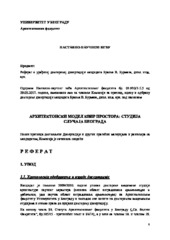Приказ основних података о дисертацији
Архитектонски модел квир простора: студија случаја Београда
Architectural model of queer space: case study of Belgrade
| dc.contributor.advisor | Đokić, Vladan | |
| dc.contributor.other | Ivanović, Zorica | |
| dc.contributor.other | Nikezić, Ana | |
| dc.contributor.other | Lazović, Zoran | |
| dc.contributor.other | Šuvaković, Miodrag | |
| dc.creator | Burmaz, Branko V. | |
| dc.date.accessioned | 2017-12-12T15:44:52Z | |
| dc.date.available | 2017-12-12T15:44:52Z | |
| dc.date.available | 2020-07-02T16:23:15Z | |
| dc.date.issued | 2017-10-20 | |
| dc.identifier.uri | http://eteze.bg.ac.rs/application/showtheses?thesesId=5408 | |
| dc.identifier.uri | https://nardus.mpn.gov.rs/handle/123456789/8936 | |
| dc.identifier.uri | https://fedorabg.bg.ac.rs/fedora/get/o:16779/bdef:Content/download | |
| dc.identifier.uri | http://vbs.rs/scripts/cobiss?command=DISPLAY&base=70036&RID=513198481 | |
| dc.description.abstract | У овом раду се испитује архитектонски модел, као низ правилности у просторним односима по којима се обликује архитектонска структура, који служи да ограничи ЛГБТК (лезбејска, геј, бисексуална, трансродна и квир) места и одвоји их од, и истовремено споји их са хетеронормативним окружењем у Београду. Истраживање се првенствено односи на последњих двадест година, од када је у Београду почела нормализација квир простора, са појављивањем првих места која су јавно самопромовисана као ЛГБТК места. Архитектонска подела, која одвајаја/спаја ова места са окружењем, истовремено служи да обликује укупни квир простор града као простор поделе. Хетеронормативност се у овом раду посматра као поредак који присилно одржава бинарну поделу међу становницима на само две нормалне групе, стрејт мушкарце и стрејт жене, од којих свака у једнозначној међузависносности одржава свој пол, род, сексуалну оријентацију, праксу и друштвену улогу, насупрот другој групи. С друге стране, појам квир се користи да би објединио све идентитете који измичу хетеронормативности. Квир простор је простор чија употреба не подлеже обавезно и на сваком свом месту хетеронормативности, већ су могућности за обликовање идентитета у њему бројне и различите, а због хетеронормативне опресије је подељен на области притиска и области слободе. Квир тела су она која у својој пракси прелазе тако насталу границу у граду, за разлику од тела која остају и опстају искључиво у хетеронормативном пољу. Циљ је да се испита улога архитектуре, истовремено и као дисциплине и као изграђене или симболичке просторне структуре, у обликовању квир простора у почетку процеса нормализације ЛГБТК идентитета у Београду. Градски квир простор се обликује кроз самоорганизовање и сасвим је игнорисан од локалне архитектонске дисциплине и њених институција... | sr |
| dc.description.abstract | In this paper we examine an architectural model, as a system of regularity in spatial relations by which is formed an architectural structure, which serves to delimit the LGBTQ (Lesbian, Gay, Bisexual, Transgender and Queer) places and separate them from, and at the same time to connect them with heteronormative environment in Belgrade. The research is primarily related to the last twenty years, since the beginning of normalization of queer space of Belgrade, with the appearance of the first places that are openly LGBTQ. Architectural division, which connects/disconnects these places with the environment, serves simultaneously to shape the queer space of the city as a whole as a space of division. Heteronormativity in this paper is seen as an order which oppressively maintains binary division among the inhabitants into two normal groups, straight men and straight women, each of which keeps its sex, gender, sexual orientation, practice and social role in an unambiguous interdependence, as opposed to the other group. On the other hand, the notion of queer is used to bring together all the identities which escape heteronormativity. Queer space is a space whose use is not always and at each of its places heteronormative. The opportunities for the creation of identity in this space are numerous and varied. Because of heteronormative oppression queer space is divided into areas of pressure and the areas of freedom. Queer bodies are those which in their practice cross the border which is produced in this way in the city, as opposed to the bodies that remain and survive in a heteronormative field only. The aim is to examine the role of architecture, both as a discipline and as built or symbolic spatial structure, in the creation of queer space at the beginning of the process of normalization of LGBTQ identities in Belgrade. Queer space of the city is formed by self-organization and it is completely ignored by local architectural discipline and its institutions... | en |
| dc.format | application/pdf | |
| dc.language | sr | |
| dc.publisher | Универзитет у Београду, Архитектонски факултет | sr |
| dc.rights | openAccess | en |
| dc.rights.uri | https://creativecommons.org/licenses/by-nc-sa/4.0/ | |
| dc.source | Универзитет у Београду | sr |
| dc.subject | квир | sr |
| dc.subject | queer | en |
| dc.subject | простор | sr |
| dc.subject | архитектура | sr |
| dc.subject | ЛГБТК | sr |
| dc.subject | геј | sr |
| dc.subject | модел | sr |
| dc.subject | унутрашња периферизација | sr |
| dc.subject | структура | sr |
| dc.subject | перформативност | sr |
| dc.subject | репрезентација | sr |
| dc.subject | space | en |
| dc.subject | architecture | en |
| dc.subject | LGBTQ | en |
| dc.subject | gay | en |
| dc.subject | model | en |
| dc.subject | inward peripherization | en |
| dc.subject | structure | en |
| dc.subject | performativity | en |
| dc.subject | representation | en |
| dc.title | Архитектонски модел квир простора: студија случаја Београда | sr |
| dc.title.alternative | Architectural model of queer space: case study of Belgrade | en |
| dc.type | doctoralThesis | en |
| dc.rights.license | BY-NC-SA | |
| dcterms.abstract | Ђокић, Владан; Ивановић, Зорица; Никезић, Aна; Лазовић, Зоран; Шуваковић, Миодраг; Бурмаз, Бранко В.; Arhitektonski model kvir prostora: studija slučaja Beograda; | |
| dc.identifier.fulltext | https://nardus.mpn.gov.rs/bitstream/id/545/IzvestajKomisije15275.pdf | |
| dc.identifier.fulltext | https://nardus.mpn.gov.rs/bitstream/id/544/Disertacija.pdf | |
| dc.identifier.fulltext | http://nardus.mpn.gov.rs/bitstream/id/544/Disertacija.pdf | |
| dc.identifier.fulltext | http://nardus.mpn.gov.rs/bitstream/id/545/IzvestajKomisije15275.pdf | |
| dc.identifier.rcub | https://hdl.handle.net/21.15107/rcub_nardus_8936 |



